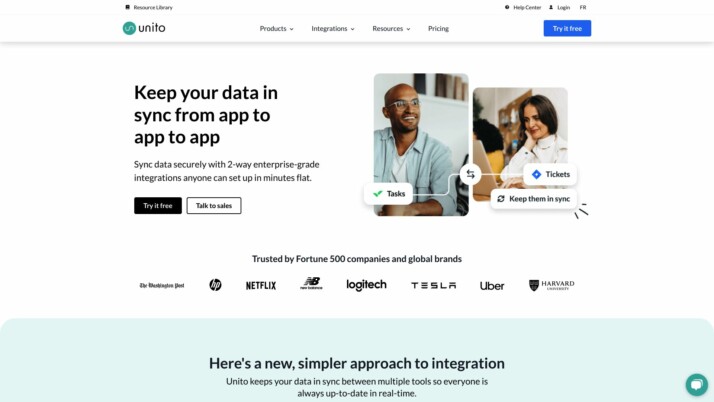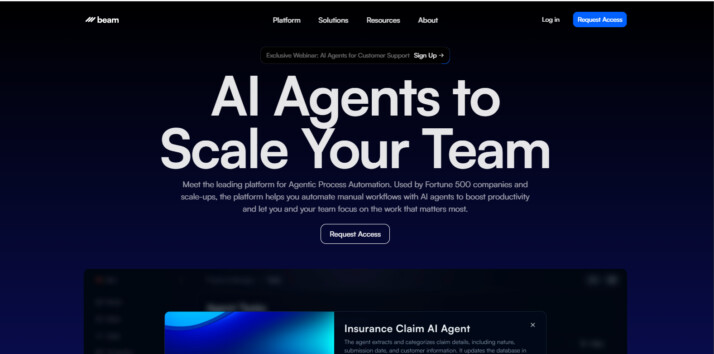Unito vs. Beam AI: Workflow Automation Showdown
AI-powered automation and workflow integration are reshaping how businesses operate, with platforms like Unito vs. Beam AI, and SmythOS leading the charge. This comparison dives into the unique strengths of each solution, exploring how they tackle workflow optimization, data synchronization, and task automation.
We’ll examine Unito’s prowess in connecting diverse tools, Beam AI’s innovative approach to generative AI agents, and SmythOS’s comprehensive AI development ecosystem. Whether you’re a developer seeking powerful APIs, a business leader focused on scalability, or a non-technical user looking for accessible AI solutions, this analysis will help you navigate the landscape of AI-driven productivity tools and choose the platform that best fits your organization’s needs.
Unito Overview
Unito provides a robust integration platform designed to streamline workflows across diverse tools and teams. The company’s Sync Platform enables seamless, real-time data synchronization between popular project management, collaboration, and development tools.


Unito’s core offering centers on its two-way sync technology, allowing teams to work in their preferred environments while maintaining data consistency across platforms. This capability proves particularly valuable for organizations juggling multiple tools or managing cross-functional projects. The platform supports deep field configuration, allowing users to customize syncs to match specific workflow requirements.
Unito’s core offering centers on its two-way sync technology, allowing teams to work in their preferred environments while maintaining data consistency across platforms.
A standout feature of Unito is its no-code approach to workflow automation. The visual workflow designer empowers users to create complex integrations without programming knowledge, making it accessible to both technical and non-technical team members. This democratization of integration capabilities aligns with the growing trend towards more user-friendly, adaptable tools in the workplace.
Security and scalability form key pillars of Unito’s offering. The platform boasts enterprise-level security measures, including SOC II Type 2 certification and HTTPS data encryption. These features, combined with the ability to sync large volumes of tasks, position Unito as a viable solution for businesses of varying sizes and industries.
While Unito excels in data synchronization and workflow automation, it’s important to note that it doesn’t offer AI agent capabilities or advanced features like autonomous problem-solving. Its strength lies in connecting existing tools and streamlining processes rather than providing AI-driven insights or decision-making support.
Beam AI Overview
Beam AI pioneers generative AI agents that automate repetitive manual tasks, boosting organizational productivity. Their Agentic Process Automations (APAs) outperform humans in speed and cost-efficiency across data extraction, customer inquiries, compliance tasks, and order processing. These agents continuously learn, improving precision over time.


Beam AI pioneers generative AI agents that automate repetitive manual tasks, boosting organizational productivity. Their Agentic Process Automations (APAs) outperform humans in speed and cost-efficiency…
Focusing on back-office automation, customer service, compliance, and order processing, Beam AI tailors solutions to specific organizational needs. The company’s AI-native approach emphasizes sustainability, minimizing steps and reducing human carbon footprints. Speed and efficiency drive their innovations, with a customer-obsessed mindset pushing continuous improvement in user experiences.
Beam AI equips its agents with advanced conversational interfaces for seamless interaction and efficient task management. These agents integrate with existing systems to plan and execute workflows, providing comprehensive automation. The company envisions a sustainable, ethical future powered by AI, aiming to build agents capable of tackling complex workflows and improving through continuous learning.
Beam AI equips its agents with advanced conversational interfaces for seamless interaction and efficient task management. These agents integrate with existing systems to plan and execute workflows…
While Beam AI offers powerful automation capabilities, it lacks some features found in more comprehensive platforms. The absence of hosted development and production environments may limit scalability for some users. Additionally, Beam AI doesn’t provide explicit support for multimodal interactions or advanced problem-solving capabilities beyond workflow automation, potentially restricting its applicability in more complex AI scenarios.
Beam AI’s focus on specific automation tasks makes it a strong contender for organizations looking to streamline operations in targeted areas. However, businesses seeking a more holistic AI development platform with extensive customization options and broader AI agent capabilities may need to explore alternative solutions that offer a wider range of features and deployment options.
Feature Comparison
Unito and Beam AI offer distinct approaches to workflow automation, with key differences in their core capabilities and focus areas. Unito excels in data synchronization across diverse tools, providing real-time two-way sync and deep field configuration. Its visual workflow designer and no-code approach make it accessible for non-technical users. In contrast, Beam AI specializes in generative AI agents for task automation, particularly in back-office operations, customer service, and compliance.
While both platforms aim to streamline workflows, they diverge significantly in their AI capabilities. Beam AI’s Agentic Process Automations (APAs) leverage advanced AI to automate complex tasks, continuously learning and improving over time. Unito, however, does not offer AI-driven agents or autonomous problem-solving capabilities, focusing instead on integrating existing tools and processes. This fundamental difference impacts their applicability to various business scenarios.
In terms of security and scalability, both platforms offer robust solutions, but with different emphases. Unito provides enterprise-level security with SOC II Type 2 certification and HTTPS encryption, catering to businesses handling sensitive data. Beam AI, while also prioritizing security, places a stronger focus on AI-native solutions that minimize steps and reduce human carbon footprints. This distinction highlights the platforms’ differing approaches to efficiency and sustainability in workflow automation.
Feature Comparison Table
| Unito | Beam AI | SmythOS | |
|---|---|---|---|
| CORE FEATURES | |||
| Visual Builder | ✅ | ❌ | ✅ |
| No-Code Options | ✅ | ❌ | ✅ |
| Autonomous Agents | ❌ | ✅ | ✅ |
| Debug Tools | ✅ | ❌ | ✅ |
| Multimodal | ❌ | ❌ | ✅ |
| Human-AI Interaction | ❌ | ✅ | ✅ |
| Agent Work Scheduler | ❌ | ✅ | ✅ |
| SECURITY | |||
| IP Control | ❌ | ✅ | ✅ |
| COMPONENTS | |||
| Foundation AIs | ❌ | ✅ | ✅ |
| Huggingface AIs | ❌ | ✅ | ✅ |
| Classifiers | ❌ | ✅ | ✅ |
| Logic | ✅ | ✅ | |
| Data Lakes | ❌ | ❌ | ✅ |
| DEPLOYMENT OPTIONS (EMBODIMENTS) | |||
| Deploy as Webhook | ❌ | ✅ | ✅ |
| Staging Domains | ❌ | ✅ | ✅ |
| Deploy as Site Chat | ❌ | ✅ | ✅ |
| Deploy as Scheduled Agent | ❌ | ✅ | ✅ |
| Deploy as GPT | ❌ | ✅ | ✅ |
| DATA LAKE SUPPORT | |||
| Hosted Vector Database | ❌ | ❌ | ✅ |
| Sitemap Crawler | ❌ | ❌ | ✅ |
| YouTube Transcript Crawler | ❌ | ❌ | ✅ |
| URL Crawler | ❌ | ❌ | ✅ |
| PDF Support | ❌ | ✅ | ✅ |
| Word File Support | ❌ | ✅ | ✅ |
| TXT File Support | ❌ | ✅ | ✅ |
Best Alternative to Unito and Beam AI
SmythOS stands out as the superior alternative to Unito and Beam AI, offering a comprehensive AI automation platform that combines the best of both worlds. Our platform empowers users with a versatile, user-friendly solution for creating and deploying AI agents across various applications.
We provide an intuitive drag-and-drop interface, making it easy for users of all skill levels to build complex AI workflows without extensive coding knowledge. This visual approach to agent creation sets us apart from Beam AI’s more technical focus and surpasses Unito’s limited AI capabilities.
SmythOS offers unlimited use cases. Our platform supports a wide range of AI models … allowing users to tackle diverse challenges from customer service to complex data analysis.
Unlike Unito’s narrow focus on data synchronization or Beam AI’s emphasis on back-office automation, SmythOS offers unlimited use cases. Our platform supports a wide range of AI models, including those from OpenAI, Anthropic, and Hugging Face, allowing users to tackle diverse challenges from customer service to complex data analysis.
SmythOS excels in its deployment options, offering flexibility that neither Unito nor Beam AI can match. Users can deploy their AI agents as APIs, webhooks, scheduled tasks, or even integrate them into popular platforms like ChatGPT. This versatility ensures that our solution can adapt to any business environment or workflow.
Our commitment to continuous improvement and innovation sets SmythOS apart. We offer features like multimodal support, advanced debugging tools, and a hosted vector database, which are absent or limited in both Unito and Beam AI. These capabilities enable users to create more sophisticated, context-aware AI agents that can handle complex tasks with ease.
Conclusion
Unito and Beam AI offer powerful solutions for workflow automation and task management, each with unique strengths. Unito excels in seamless data synchronization across diverse tools, providing real-time updates and deep customization options. Its no-code approach and visual workflow designer make it accessible for non-technical users. Beam AI, on the other hand, leverages generative AI agents to automate repetitive tasks, continuously learning and improving over time.
While both platforms address workflow optimization, SmythOS stands out as the superior choice for businesses seeking a comprehensive AI development and deployment solution. Our platform combines the best of both worlds — offering seamless integrations like Unito and advanced AI capabilities like Beam AI — while providing additional features that propel it ahead of the competition.
SmythOS’s drag-and-drop interface, extensive integration ecosystem, and support for multiple AI models make it incredibly versatile and user-friendly. Our platform enables the creation of sophisticated multi-agent systems, supports multimodal interactions, and offers unparalleled deployment flexibility. Whether you need to create APIs, chatbots, or scheduled agents, SmythOS provides the tools to build and deploy AI solutions across various environments with ease.
Experience the future of AI development and workflow automation with SmythOS. Create a free account today and discover how our platform can transform your business processes, boost productivity, and drive innovation. With our risk-free trial and comprehensive documentation, you can explore the full potential of SmythOS and see firsthand why it’s the preferred choice for businesses looking to harness the power of AI.
Last updated:
Disclaimer: The information presented in this article is for general informational purposes only and is provided as is. While we strive to keep the content up-to-date and accurate, we make no representations or warranties of any kind, express or implied, about the completeness, accuracy, reliability, suitability, or availability of the information contained in this article.
Any reliance you place on such information is strictly at your own risk. We reserve the right to make additions, deletions, or modifications to the contents of this article at any time without prior notice.
In no event will we be liable for any loss or damage including without limitation, indirect or consequential loss or damage, or any loss or damage whatsoever arising from loss of data, profits, or any other loss not specified herein arising out of, or in connection with, the use of this article.
Despite our best efforts, this article may contain oversights, errors, or omissions. If you notice any inaccuracies or have concerns about the content, please report them through our content feedback form. Your input helps us maintain the quality and reliability of our information.
